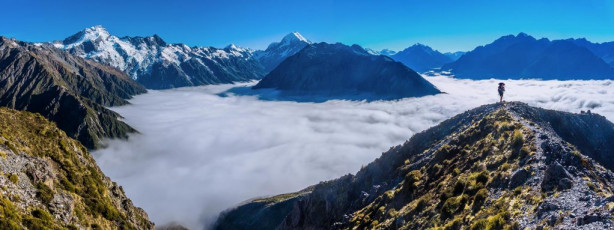
Day one dawned with what seemed to be dense cloud, which didn’t fit the weather forecast indicating fine weather for the coming three days. We set off from the road end at the base of Mount Sebastopol at 8am and made quick progress up the tourist trail to the Red Tarn. As we ascended, to our delight we soon breached the foggy cloud blanketing the entire valley and climbed into a perfect bluebird day. The sweat was soon dripping on the sustained, steep haul up to the top of Sebastopol with our heavy packs. It took a couple of hours to get to the top (1,468m), but our effort was rewarded with a crystal clear view of our intended route, as well as a 360 degree panorama of the national park.
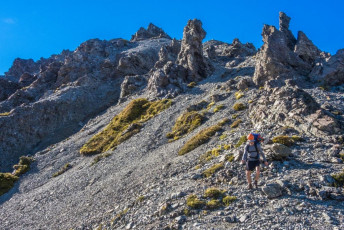
The top hundred or so metres of Sebastopol are quite steep and craggy, demanding focus and care in places. The terrain was very dry, with a lot of loose, shattered rock about. This remained the case during our entire trip and presented one of the biggest hazards facing us. Beyond Sebastopol we reached a dip in the ridge before recommencing our ascent.
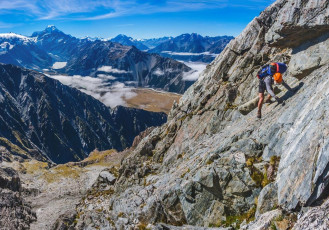
It was fairly gradual and undulating, resembling a ridge top in the Tararuas for a couple of hours, but then things got more interesting at about 1,750m. This is where the ridge becomes a serrated knife edge of rock teeth. We found our way onto the north side of the ridge, picking our way around bluffs and across little shelves.
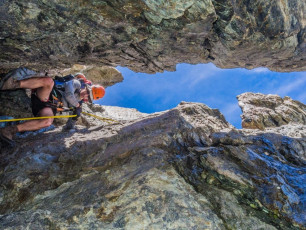
At one point we had to get the rope out to abseil into a small chasm, thereby avoiding an exposed move around a corner that was less than generous with hand holds.
Progress was slower than we’d anticipated and we found ourselves at the top of the rock teeth about 2pm. Although the route from there up onto the Plateau is meant to go left across and up a crevassed snow slope, we opted for what looked to be a straight forward headwall of snow to the right. We could see that it steepened near the top but I thought we could follow the rock on the far side to the top okay.
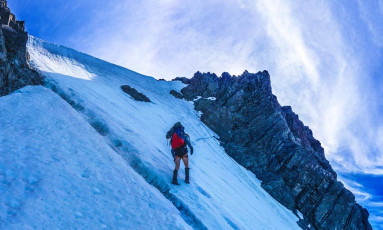
The headwall turned out to be a bit of a baby-faced assassin. As we climbed the gradient quietly increased, creeping up on us. As we neared the top hidden crevasses became apparent as we kicked with increasing concern into the steep snow. It wasn’t a spot to put in a viable snow anchor and the notion of retreat wasn’t too appealing either. As the gradient reached somewhere near seventy degrees I realised that a fall now was not an option. My heart was pounding as I cleared the lip, only to find myself on top of a series of crevasses. Not pretty, but after taking some deep breaths I could see that safety was just a few careful steps away. I shouted back to Mike to get a stable stance and I’d send down the rope end for him to tie in to. My belay point around the biggest rock I could find amongst a sea of broken choss wouldn’t have won any awards for alpine finesse, but it did the job.
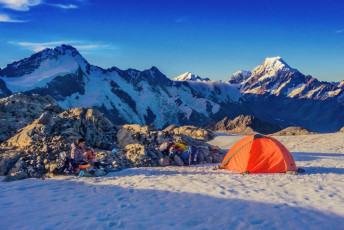
Once safely up on the eastern edge of the Plateau the world took on an entirely different demeanor. Before us stretched a broad, flat expanse of frozen snow and glacial ice, all ringed by rocky walls and peaks. Further in the distance to the north and west towered the Main Divide. It was completely calm and clear, which is how it remained for the next two days.
By now it was after 4pm and we were conscious that our day was drawing to its end. We headed off across the Plateau in search of a suitable spot to pitch our tent. On the way Mike applied his axe to a spot of plumbing work, sculpting a small hollow where glacial melt flowed so we could replenish our drinking water. This was a bonus, as we’d expected that my Jetboil would get a trashing melting snow for drinking water. This option was much quicker and easier.
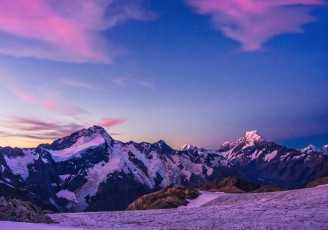
On the south western side of the Plateau we found a rocky outcrop affording both shelter and a series of little pools of clean water – an even easier water source than glacier melt. We pitched our tent, fired up the Jetboil and settled in for a beautiful sunset. The ice cliffs off Sefton and other nearby peaks took on mauve hues, belying the lethal danger that their constant ice avalanches posed.
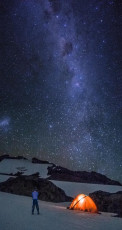
About 3am Mike grunted into action. His bladder finally drove him from the warmth of his bag and I figured I might as well do the same. Just as well, because a quick look skywards was enough to have me diving for my camera and tripod. The Milky Way and countless other galaxies were spray-painted in silver right across the sky. For once looking relatively tiny, Aoraki and her other 3,000 metre plus companions provided a striking silhouette at the base of this spectacle. I climbed, shivering but smiling, back into my bag about 4.30am.
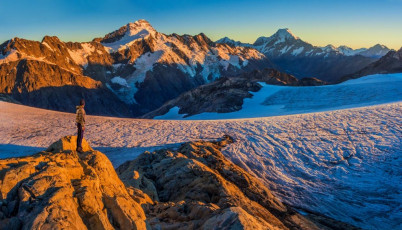
Being in situ up on the Plateau, we weren’t in any hurry next morning. While the youth slept I did get up for dawn and captured another round of beautiful alpine images. Once the suns’ rays reached our tent about 8am Mike also roused and we got ready for a primo day in the mountains.
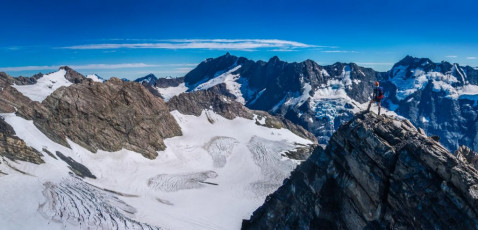
Simon Middlemass had shared some local knowledge with us before we’d set out from Unwin Lodge the morning before, cautioning us about venturing on to the north ridge of Sealy and indeed, anywhere too near the peak, due to high danger of rock fall. With this in mind our commitment to attempting the peak was already low, but we set out westward in the direction of Metelille Glacier to at least take a look.
As is often the case in the mountains, distances proved to be further than they appeared. We reached the cliffs on the western edge of the Plateau and realised that we had two options – either drop down and around the cliffs before re-ascending up the Metelille Glacier to Sladden Saddle, then perhaps, trying Sealy from the south side, or Massey. Or, our second option was to trace the rim of the Plateau southward to Barrow Col, where we could check the north ridge of Sealy out and either try it or back off and complete a full circuit of the Plateau. Option two it was.
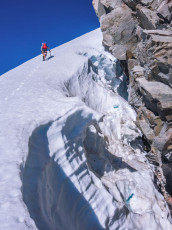
Some rock scrambling and cramponing up some steep snow slopes got us up to a high point at 2,450m, just north of Barrow Col.
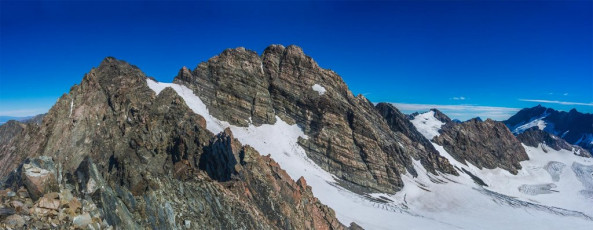
Ahead lay a world of exposure, steepness and choss. Yeah, but nah - we could certainly see what Simon was saying. Once we gave ourselves permission to abandon our north ridge objective all tension fell away and we enjoyed a romp around the rest of the Plateau, taking in the remaining high points on the rim, including Mount Annette.
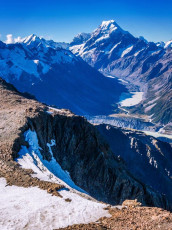
From Annette we had a different view of the headwall we’d climbed to access the Plateau the day before and could see why it had felt scary. We also enjoyed ever changing views of Sefton, Aoraki and all the other peaks along and east of the Main Divide. By the time we returned to our campsite about 5.30pm we hadn’t climbed anything of note, but it was still a fantastic day out.

Looking across the Annette Plateau from its northern end to Mt Sealy (centre) and the Main Divide (right).

Dawn view of Mounts Sefton, Footstool, La Perouse, Hicks, Cook, the Minarets and Elie De Beaumont
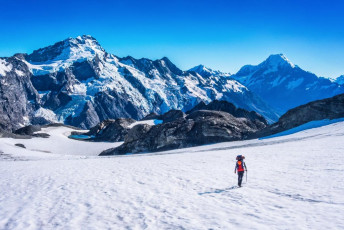
Day three we awoke to another calm, crystal clear morning. Our impression from the guide books was that we didn’t have anything challenging ahead of us. From the Plateau to Mueller Hut is only about 4km and a 400m drop in height. Mount Kitchener is graded a one. So at 10.30am, we set out in no particular hurry. Dropping across and down the Plateau into new and spectacular terrain was sheer enjoyment, but the closer we got to Kitchener the less assured we were about a nice safe route.
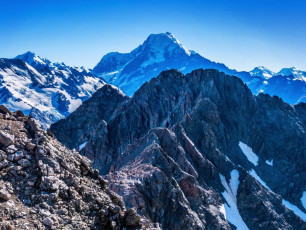
At about 2,000m were stowed our crampons and climbed eastward back up onto the rocky ridge leading over Waihi pass (1,931m) to Kitchener (2,042m). If anything, the condition of the rock down here was at its worst, demanding constant concentration. Everywhere it was bone dry, fractured and tottering, making protection placement very difficult. At one point on a particularly treacherous section I took a short tumble while trying to dodge a rock Mike had accidentally dislodged above me. After that progress slowed further as we had to wait while one descended to a safe spot before the other followed.
We eventually reached the base of the summit cliffs of Kitchener and could see a steep chute that gave access to the summit. But a sheer section about ten metres high looked too daunting. We tried another line diagonally right but that only ended beneath sheer cliffs. “Hmmm, how can this be a one” we anguished. Surely it must be a winter grade, when there’s a lot more snow about to work with and things are frozen together. Time for lunch and a rethink.
From our sandwich point we just couldn’t see a safe way up. Reluctantly we concluded that the sensible thing to do was to retreat and traverse around on the west side to reach Mueller Hut. We also noted that the top didn’t look particularly friendly either. What if we did manage to climb to the top and there was no way forward? We certainly wouldn’t want to down climb the way we came up without bullet proof protection. So, down we went.
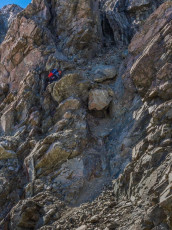
As I passed the steep section beneath the summit chute and saw it from a new perspective I suddenly saw a possible way up and said so. Youthful exurberance kicked in. “I’ll give it a go” and Mike made a beeline to the base of the chute. “Shite, now I’ve done it!”
Mike did well, methodically picking his way up, reaching a safe spot to stop so I could follow without having any lose rock topple onto me. Another very airy little move just below the summit on untrustworthy rock saw us on top at about 2pm. And our fear was realised – a very exposed, sheer notch lay between us and the true summit a few metres above us – we couldn’t go forward.
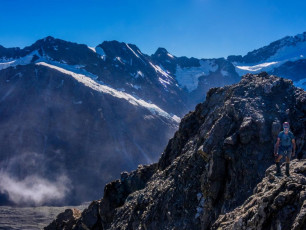
For a fleeting moment I dwelt on the PLB sitting in the top of my pack. No way, I’d never live that one down. Big breathes, map out, take stock. YES! There was a possible escape route down the east side. A chute dropped to slabs fifty metres or so below. They appeared to end in cliffs from where we stood, but the map suggested a better prognosis, so down we went.
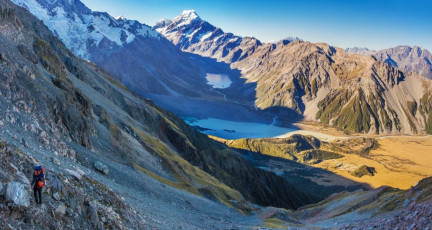
Upon reaching the slabs it became apparent that there was a way down to a snow field peppered with fallen rocks, which then led to tussocky shelves. Out of range of any airborne missiles at the bottom of the snow, we stopped for a breather, letting the tension we’d been feeling ease away. It had been a really insightful experience having to pick our own route without any prior instructions. While some people thrive on it, I don’t enjoy uncertainty; and when I feel real fear it’s probably a signal to myself that I’ve pushed it a bit too far. I learn more about my emotional limits each time I push my boundaries and Kitchener had unexpectedly done that. I may not like to admit it, but perhaps I’m learning that I’m more a photographer than a climber.
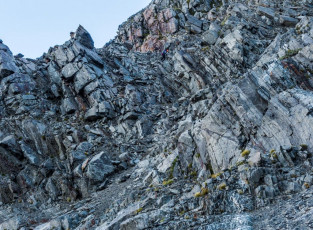
It was nice to get off the really steep stuff, but we weren’t quite out of the woods yet. The valley we had ended up in was rapidly culminating in very steep rubble and bluffs. Another look at the map and Mike proposed that we climb out of the valley we were in and join the next, which had slightly more widely spaced topos. Good idea Mike – on the ridge between the two valleys we soon saw a monster scree slope extending from Kitchener’s ridge top all the way to the valley floor. A few obstacles still had to be overcome, but it was all do-able.
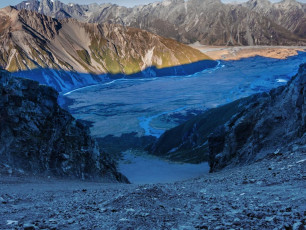
We found ourselves on the narrow neck of the scree slope at 5pm. A cold beer that evening now looked on the cards, which was hugely appealing since we’d just run out of water. From where we stood it looked like we could be down a thousand metres to the valley floor in a couple of hours if the scree was of good quality.
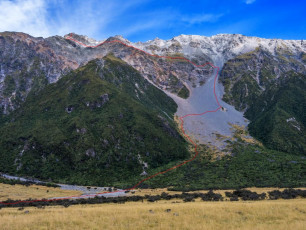
Yeah, but nah. Again the scale of this magnificent landscape completely fooled us. Bruised and battered from countless slips on the horrid, unpredictable rubble (not scree) in our end of day tired state, we trudged in to the Hermitage to get a drink of water in the toilets at 9pm. A few passing restaurant guests gorked, but at least the weather was STILL beautiful and the pub was still serving large jugs of Speights at 10pm when we eventually arrived there. What a day, what a trip. Humbled again. Chhheeeers!









